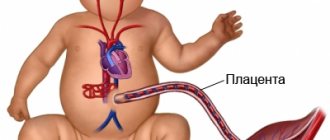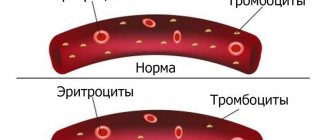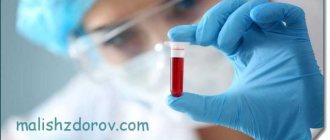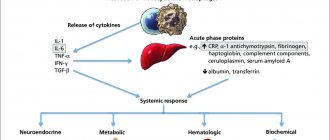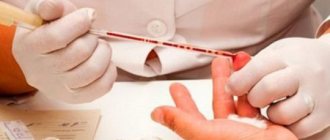A little about blood and its functions
Blood is a biological medium through which the body is nourished and saturated with nutrients and oxygen. It is represented by plasma (liquid part) and formed elements (erythrocytes, leukocytes, platelets).
The ratio of all components, that is, plasma to blood cells, is 6:4. If the balance is disturbed and the shift occurs in favor of cellular particles, then the blood becomes thicker and more viscous.
This entails problems with oxidation and restoration of tissues of some organs (renal apparatus, liver, brain). The bloodstream is filled with loose blood clots that lack elasticity.
Hypercoagulation: mechanism of occurrence
The causes of hypercoagulation are associated with:
- Increased content of procoagulants in the bloodstream. These changes were noticed with thrombocytosis, severe hyperprothrombinemia,
- Increased formation of activated coagulation elements,
- Reducing the number of fibrinolytic factors. Observed in atherosclerosis, vasculitis,
- Inhibition of the activity of anticoagulants. Characteristic in cases of shock, blood poisoning, burns.
There are 2 forms of hypercoagulation:
- Primary. Occurs due to genetic predisposition,
- Secondary. It is a response to existing diseases of the body.
Damage due to hypercoagulability
Blood: coagulation, intrinsic pathway of activation
It is known that contact of blood with a non-natural surface (for example, the glass of a test tube) leads to blood clotting, which is explained by the activation and interaction of factors originally present in the blood. Accordingly, this coagulation pathway (mechanism) is called internal (Intrinsic pathway). More precisely, it can now be defined as a sequence of reactions that cause the formation of factor Xa (or prothrombin-converting activity) due to the activation and interaction of coagulation factors present in the blood.
The trigger point for the sequence of reactions of the internal pathway is the contact of factor XII with the components of the subendothelium (see Blood: coagulation, diagram). The negatively charged surface of subendothelial collagens and the surface of activated platelets are highly affinity for f.XII and high molecular weight kininogen, which is in complex with prekallikrein and f.XI.
Spontaneously activated by a negatively charged surface, f.XII is converted through conformational changes into f.alpha-XIIa, which stimulates the formation of the enzyme kallikrein as a result of a limited proteolysis reaction. The latter, according to the principle of positive feedback, enhances the activation of f.XII, converting it into serine proteinase f.beta-XIIa. F.beta-XIIa activates f.XI. Thrombin and plasmin can be activators of f.XI.
Many authors believe that activation of f.XI is central to the stimulation of the intrinsic blood coagulation mechanism. In this case, the Arg-369-Ile bond in each of the subunits of f.XI is cleaved, which leads to the formation of f.XIa, which can activate f.XI according to the principle of autocatalysis. F.ХIа transforms f.IX into f.
The internal pathway continues with the activation of factor X, in which platelet membrane phospholipids and calcium ions play an important role. Thanks to calcium ions, activated factor IX (factor IXa), factor VIII (including thrombin-activated factor VIIIm) and factor X bind to phospholipids of platelet membranes, which have coagulation activity (platelet factor 3), and acquire such spatial configurations that provide activation of factor X (via proteolysis).
After the formation of activated factor X (factor Xa), the internal pathway has the same development (continuation) as the external pathway of activation of blood coagulation.
Etiology of hypercoagulability formation
The following etiological factors can affect changes in blood composition and lead to the development of hypercoagulation:
- Intoxication with dyspeptic conditions, when fluid losses are not replenished. This occurs with kidney disease, diabetes, pulmonary edema, and burns. After recovery, blood viscosity returns to normal,
- Taking certain medications, including oral contraceptives. Blood fluidity is restored after stopping medication,
- Excess body weight. The blood becomes too viscous due to hypercholesterolemia,
- Helminthiasis,
- Infection of the body with various viruses and pathogenic bacteria,
- Cirrhosis of the liver,
- Hepatitis,
- Heart surgery with installation of an artificial valve,
- Autoimmune diseases,
- Malignant and benign tumors. The most common: myeloma, fibroids, hemangioma, lipoma, leukemia,
- Problems with the adrenal glands
- Blood and vascular pathologies: varicose veins, atherosclerosis, erythremia,
- Connective tissue diseases: systemic lupus erythematosus, vasculitis.
Other prerequisites for development
Hypercoagulation syndrome most often has a congenital character, but it may well develop against the background of the influence of external conditions. There are several factors under which the occurrence of the disease cannot be ruled out:
- prolonged neuroses and stress;
- vascular damage;
- oncology;
- erythremia;
- antiphospholipid syndrome;
- Wellebrand's disease;
- contact of plasma with foreign surfaces;
- hematogenous thrombophilias;
- impressive hemangiomas;
- postpartum period and pregnancy;
- autoimmune disorders - lupus erythematosus, aplastic anemia, thrombocytopenic purpura;
- atherosclerosis of the coronary arteries;
- severe bleeding from the digestive tract;
- taking estrogen during menopause;
- use of contraceptive pills;
- synthetic heart valve and hemodialysis.
Pathology can be caused by several factors at once. Treatment of hypercoagulability syndrome largely depends on the causes of its occurrence.
Diagnostic measures for hypercoagulability
To diagnose hypercoagulation, a clinical picture alone is not enough, because it is characteristic of many pathological conditions. Doctors prescribe a laboratory test, during which venous blood is taken. The laboratory technician immediately notices that only the blood taken immediately coagulates in the needle.
A coagulogram allows you to determine changes in the following blood parameters:
| Name of blood component | Deviations from the norm |
| Fibrinogen | More than 4 g/l |
| Prothrombin | More than 142% |
| Plasma tolerance to heparin | Less than 7 minutes |
| Thrombin time | Less than 12 s |
| RFMK-test | More than 4.0 mg/100ml |
| Partial activated thromboplast time | Less than 25 s |
A coagulogram gives an idea of the state of blood vessels and hemostasis. The efficiency of coagulation is also determined, which occurs along the internal and general coagulation pathways.
In the expert's conclusion, concepts such as chronometric and structural hypercoagulation are found. The first is associated with pregnancy, and the second with serious disorders in the body.
Diagnostics
If this disease is suspected, the specialist must collect anamnesis, assess the nature of the patient’s symptoms and complaints, the presence of miscarriages and genetic factors. Laboratory tests are then performed to detect increased blood viscosity:
- general blood test to determine the number of formed elements, hemoglobin concentration;
- coagulogram to obtain information about the state of the hemostatic system, the level of coagulation, and the duration of bleeding;
- activated thromboplastin time to assess the effectiveness of coagulation pathways.
To determine the condition of internal organs and blood vessels, instrumental diagnostics of hypercoagulation syndrome are additionally performed:
- Doppler ultrasound;
- MRI, ultrasound;
- phlebography.
Among other things, the doctor must differentiate this pathology from DIC syndrome, hemolytic-uremic disease and malignant tumors.
Hypercoagulation in pregnant women
Moderate hypercoagulation during pregnancy is a common and natural phenomenon.
Indeed, during this period, the activity of the blood coagulation system of the mother and unborn child is greatly increased. Hypercoagulability syndrome prevents the patient from large blood loss during the birth process.
Chronometric hypercoagulation is observed starting from the second trimester of pregnancy.
Various factors that are not related to the latter’s lifestyle can provoke pathological hypercoagulation in a pregnant woman:
- Diseases of internal organs (renal apparatus, liver, heart and blood vessels),
- Nervous shocks (stress, depression),
- Mutations at the gene level
- Patient's age (usually over 40 years).
To avoid the negative consequences of hypercoagulation, changes in hemostasis in a pregnant woman should be under medical supervision. It consists of monthly blood donation for coagulation and clotting tests. If the diagnosis is confirmed, diagnostics are carried out every 2 weeks.
If signs of hypercoagulation are detected, the patient is prescribed drug therapy that is safe for the fetus.
It will be able to protect against thrombosis of the spiral arteries, which is the cause of several serious complications:
- Fetal development is delayed
- The placenta wears out too quickly
- The fetus dies during pregnancy.
Symptoms of hypercoagulability syndrome
During pregnancy, the pathology can manifest itself with a pronounced clinical picture. But in other people, increased viscosity may not have specific manifestations. True, there are many abnormalities that can help suspect and identify the disease. Symptoms of the syndrome include:
- dizziness with slight loss of coordination;
- fatigue, weakness;
- aching migraines;
- muscle weakness;
- nausea, fainting;
- insomnia;
- presence of chronic problems;
- cyanosis of the skin and mucous membranes, their increased dryness;
- cold feet, feeling of heaviness and pain in the limbs;
- loss of sensitivity in the legs and arms, numbness, burning;
- too high susceptibility to cold;
- pain in the heart area - tingling, arrhythmia, shortness of breath;
- increased anxiety, depression, absent-mindedness;
- deterioration of vision and hearing, the appearance of tinnitus;
- burning in the eyes, tearing;
- increased hemoglobin level;
- slow bleeding from wounds, cuts, scratches;
- miscarriage, constant miscarriages;
- frequent yawning.
All the described signs require careful diagnosis. After a complex of laboratory and instrumental examinations, a specialist can identify pathology.
A few facts about hypocoagulation
The opposite phenomenon of increased blood clotting is hypocoagulation. With reduced blood clotting, frequent bleeding and hemorrhages are observed, occurring spontaneously or after minor injuries.
The causes of hypocoagulation are:
- Hepatitis and other liver diseases,
- Acute blood loss,
- Hereditary thrombocytopathies,
- Abuse of anticoagulants,
- Anemia,
- DIC syndromes.
How to deal with hypercoagulation?
Hypercoagulation is a problem that should be solved together with highly specialized specialists. Treatment is selected individually for each patient. Therapeutic measures to restore normal blood flow must cover several aspects at once.
They have to:
- Improve metabolic processes,
- Prevent the occurrence of blood clots and treat existing formations,
- Eliminate the cancerous process of hematopoietic tissues.
Thus, doctors, using medications and procedures:
- Eliminate the causes of hypercoagulation,
- Normalize the volume of circulating blood,
- Improve microcirculation, hemodynamics,
- Maintain normal hematocrit.
The main groups of drugs used for pathologies of the blood coagulation system:
| Group of drugs | Function | Representatives |
| Anticoagulants | Aspirin-based products thin the blood and prevent the formation of blood clots. | "Heparin", "Warfarin", "Fragmin". |
| Fibrinolytics | “Fortelizin”, “Thromboflux”, “Streptase”. | |
| Antiplatelet agents | "Cardiomagnyl", "Acetylsalicylic acid", "Thrombo ACC". | |
| Antispasmodics | Eliminate spasms. | “Papaverine”, “No-shpa”, “Spazmalgon”. |
| Anti-inflammatory | Relieves inflammation. | "Indomethacin", "Ibuklin" |
| Vascular | Improve blood circulation, expanding the vascular lumen. | "Curantil", "Pentoxifylline" |
| Antibiotics+antiproteases | Eliminate bacterial infection | "Cefazolin" + "Contrical" |
| "Azithromycin" + "Gordox" | ||
| Steroid hormones | Eliminate autoimmune disorders | "Dexamethasone", "Prednisolone" |
When a state of shock develops, the following is administered intravenously:
- albumin solution,
- Plasma + heparin,
- saline solution,
- "Reopoliglyukin".
In severe clinical situations, donor blood transfusions are resorted to.
Drugs
Most often, specialists prescribe medications in this case (for example, the drug “Thrombo ACC”, which has aspirin as the main component) that dilute platelets. Along with them, it is also possible to use traditional medicine techniques. For example, meadowsweet, from which not only tinctures are made, but also various kinds of preparations.
Its components are unique and can replace aspirin. Meadowsweet is prescribed by many doctors for diseases of the blood system and blood vessels, including hypercoagulation along the internal pathway of blood coagulation. If a pregnant patient is undergoing treatment, then the therapeutic course should be selected especially carefully.
When treating patients who have other diseases along with this syndrome, Syncumar or Warfarin, which are anticoagulants, are often prescribed. If significant bleeding occurs during hypercoagulation (what it is is now known), then patients require blood transfusions from donors. In addition, it is possible to use saline or colloidal solutions.
To achieve the desired results from treatment, patients are required to follow the instructions of their physician with precision and adhere to recommendations such as:
- maintaining a healthy lifestyle;
- giving up various kinds of bad habits (for example, smoking can be one of the factors contributing to the development of hypercoagulation along the internal route);
- exclusion of significant physical activity;
- proper nutrition.
To be or not to be a diet?
For those patients who have been diagnosed with hypercoagulation, doctors recommend reconsidering their diet.
The following categories of products should be excluded or reduced from the menu:
- Canned food and marinades,
- Sweet and floury,
- Fatty, fried, salty and spicy foods,
- Smoked meats,
- Buckwheat,
- Potato,
- Bananas,
- Alcohol,
- Sweet sparkling water.
It is recommended to enter into the menu:
- Low-fat fermented milk products,
- Meat and fish dishes
- Dark chocolate and cocoa,
- Vegetables (tomatoes, cucumbers, beets),
- Fruits (lemons, oranges, apples, peaches),
- Berries (cherries, cranberries, currants).
It is important that food is cooked by boiling, stewing or steaming.
Doctors advise eating 1 tablespoon of sprouted wheat grains once a day. They are able to change blood flow for the better.
Traditional medicine for hypercoagulation
Along with traditional medicine, it is possible to use traditional medicine recipes to treat hypercoagulation.
A decoction gives a good medicinal effect:
- Based on lemon balm, meadow clover, yellow sweet clover, valerian, hawthorn . An equal amount of ingredients is poured with boiling water (400 ml). The mixture is infused in a steam bath for 15 minutes. Drink the prepared decoction 1 glass twice a day.
- From willow bark (1 tablespoon). The plant is poured with 500 ml of boiling water. The mixture is infused for about 2 hours. The medicine is taken twice a day, 1 glass.
- From dried meadowsweet (40 g). She pours a glass of boiling water. Drink the prepared liquid as soon as it cools down. Duration of treatment is about 2 weeks.
General recommendations for patients with hypercoagulability
To prevent the development of hypercoagulation, experts recommend following:
- Healthy lifestyle . It is necessary to quit smoking and drinking alcohol, and play sports.
- Work and rest schedule . You need to optimize your workday, get good sleep, and avoid stress.
- Diet.
- Timing of blood donation for the purpose of preventive diagnostics.
It is extremely difficult to predict the further course of such a phenomenon as hypercoagulation. It depends on the severity of the underlying disease, the patient’s overall health, and hemostasis parameters.
Timely diagnosis of hypercoagulation and treatment of the underlying disease helps to avoid complications and bring blood circulation back to normal.


